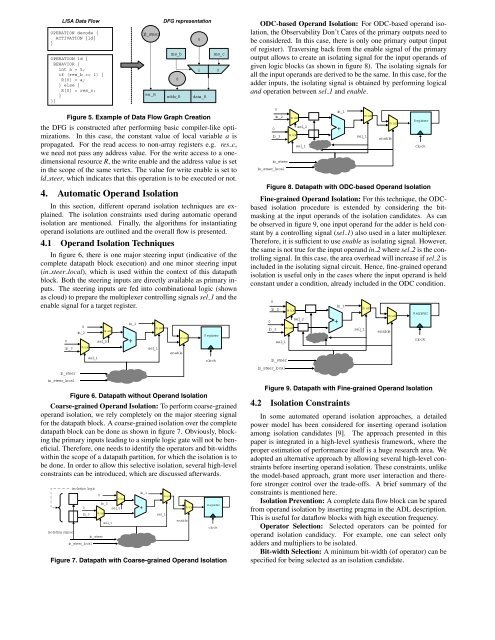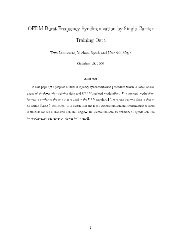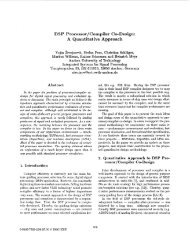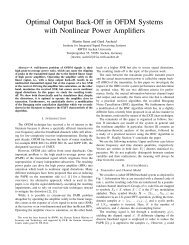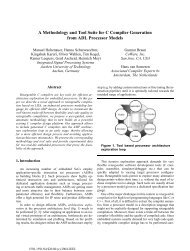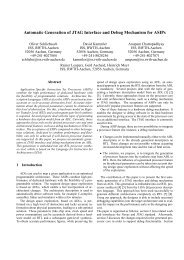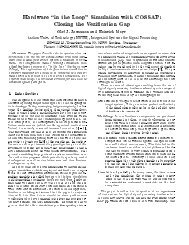Automatic ADL-based Operand Isolation for Embedded Processors
Automatic ADL-based Operand Isolation for Embedded Processors
Automatic ADL-based Operand Isolation for Embedded Processors
You also want an ePaper? Increase the reach of your titles
YUMPU automatically turns print PDFs into web optimized ePapers that Google loves.
,6$'DWD)ORZ<br />
OPERATION decode {<br />
ACTIVATION {ld}<br />
}<br />
OPERATION ld {<br />
BEHAVIOR {<br />
int a = 5;<br />
if (res_b == 1) {<br />
R[0] = a;<br />
} else {<br />
R[0] = res_c;<br />
}<br />
}}<br />
ld_steer<br />
ew _R<br />
')*UHSUHVHQWDWLRQ<br />
res_b<br />
0<br />
addr_R<br />
5<br />
data_R<br />
res_c<br />
1 0<br />
Figure 5. Example of Data Flow Graph Creation<br />
the DFG is constructed after per<strong>for</strong>ming basic compiler-like optimizations.<br />
In this case, the constant value of local variable a is<br />
propagated. For the read access to non-array registers e.g. res c,<br />
we need not pass any address value. For the write access to a onedimensional<br />
resource R, the write enable and the address value is set<br />
in the scope of the same vertex. The value <strong>for</strong> write enable is set to<br />
ld steer, which indicates that this operation is to be executed or not.<br />
4. <strong>Automatic</strong> <strong>Operand</strong> <strong>Isolation</strong><br />
In this section, different operand isolation techniques are explained.<br />
The isolation constraints used during automatic operand<br />
isolation are mentioned. Finally, the algorithms <strong>for</strong> instantiating<br />
operand isolations are outlined and the overall flow is presented.<br />
4.1 <strong>Operand</strong> <strong>Isolation</strong> Techniques<br />
In figure 6, there is one major steering input (indicative of the<br />
complete datapath block execution) and one minor steering input<br />
(in steer local), which is used within the context of this datapath<br />
block. Both the steering inputs are directly available as primary inputs.<br />
The steering inputs are fed into combinational logic (shown<br />
as cloud) to prepare the multiplexer controlling signals sel 1 and the<br />
enable signal <strong>for</strong> a target register.<br />
0<br />
in_3<br />
in_steer<br />
in_steer_local<br />
0<br />
in_2<br />
mux<br />
sel_1<br />
sel_2<br />
mux<br />
in_1<br />
+<br />
sel_1<br />
mux<br />
enable<br />
mux<br />
Figure 6. Datapath without <strong>Operand</strong> <strong>Isolation</strong><br />
Register<br />
clock<br />
Coarse-grained <strong>Operand</strong> <strong>Isolation</strong>: To per<strong>for</strong>m coarse-grained<br />
operand isolation, we rely completely on the major steering signal<br />
<strong>for</strong> the datapath block. A coarse-grained isolation over the complete<br />
datapath block can be done as shown in figure 7. Obviously, blocking<br />
the primary inputs leading to a simple logic gate will not be beneficial.<br />
There<strong>for</strong>e, one needs to identify the operators and bit-widths<br />
within the scope of a datapath partition, <strong>for</strong> which the isolation is to<br />
be done. In order to allow this selective isolation, several high-level<br />
constraints can be introduced, which are discussed afterwards.<br />
isolating signal<br />
isolation logic<br />
0<br />
in_3<br />
in_steer_local<br />
0<br />
mux<br />
in_steer<br />
in_2<br />
sel_1<br />
sel_2<br />
mux<br />
in_1<br />
+<br />
sel_1<br />
mux<br />
enable<br />
mux<br />
Register<br />
clock<br />
Figure 7. Datapath with Coarse-grained <strong>Operand</strong> <strong>Isolation</strong><br />
ODC-<strong>based</strong> <strong>Operand</strong> <strong>Isolation</strong>: For ODC-<strong>based</strong> operand isolation,<br />
the Observability Don’t Cares of the primary outputs need to<br />
be considered. In this case, there is only one primary output (input<br />
of register). Traversing back from the enable signal of the primary<br />
output allows to create an isolating signal <strong>for</strong> the input operands of<br />
given logic blocks (as shown in figure 8). The isolating signals <strong>for</strong><br />
all the input operands are derived to be the same. In this case, <strong>for</strong> the<br />
adder inputs, the isolating signal is obtained by per<strong>for</strong>ming logical<br />
and operation between sel 1 and enable.<br />
0<br />
0<br />
in_2<br />
in_3<br />
in_steer<br />
in_steer_local<br />
mux<br />
mux<br />
sel_2<br />
sel_1<br />
in_1<br />
+<br />
sel_1<br />
mux<br />
enable<br />
mux<br />
Register<br />
clock<br />
Figure 8. Datapath with ODC-<strong>based</strong> <strong>Operand</strong> <strong>Isolation</strong><br />
Fine-grained <strong>Operand</strong> <strong>Isolation</strong>: For this technique, the ODC<strong>based</strong><br />
isolation procedure is extended by considering the bitmasking<br />
at the input operands of the isolation candidates. As can<br />
be observed in figure 9, one input operand <strong>for</strong> the adder is held constant<br />
by a controlling signal (sel 1) also used in a later multiplexer.<br />
There<strong>for</strong>e, it is sufficient to use enable as isolating signal. However,<br />
the same is not true <strong>for</strong> the input operand in 2 where sel 2 is the controlling<br />
signal. In this case, the area overhead will increase if sel 2 is<br />
included in the isolating signal circuit. Hence, fine-grained operand<br />
isolation is useful only in the cases where the input operand is held<br />
constant under a condition, already included in the ODC condition.<br />
0<br />
0<br />
in_2<br />
in_3<br />
sel_1<br />
in_steer<br />
in_steer_local<br />
mux<br />
mux<br />
sel_2<br />
+<br />
in_1<br />
sel_1<br />
mux<br />
enable<br />
mux<br />
Register<br />
clock<br />
Figure 9. Datapath with Fine-grained <strong>Operand</strong> <strong>Isolation</strong><br />
4.2 <strong>Isolation</strong> Constraints<br />
In some automated operand isolation approaches, a detailed<br />
power model has been considered <strong>for</strong> inserting operand isolation<br />
among isolation candidates [9]. The approach presented in this<br />
paper is integrated in a high-level synthesis framework, where the<br />
proper estimation of per<strong>for</strong>mance itself is a huge research area. We<br />
adopted an alternative approach by allowing several high-level constraints<br />
be<strong>for</strong>e inserting operand isolation. These constraints, unlike<br />
the model-<strong>based</strong> approach, grant more user interaction and there<strong>for</strong>e<br />
stronger control over the trade-offs. A brief summary of the<br />
constraints is mentioned here.<br />
<strong>Isolation</strong> Prevention: A complete data flow block can be spared<br />
from operand isolation by inserting pragma in the <strong>ADL</strong> description.<br />
This is useful <strong>for</strong> dataflow blocks with high execution frequency.<br />
Operator Selection: Selected operators can be pointed <strong>for</strong><br />
operand isolation candidacy. For example, one can select only<br />
adders and multipliers to be isolated.<br />
Bit-width Selection: A minimum bit-width (of operator) can be<br />
specified <strong>for</strong> being selected as an isolation candidate.


